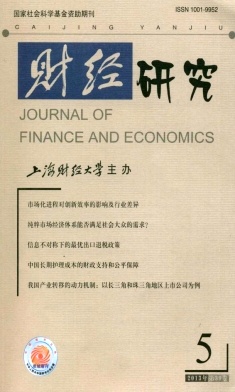财富对创业的异质性影响——基于三省农户的实证分析
财经研究 2013 年 第 39 卷第 05 期, 页码:135 - 145
摘要
参考文献
摘要
文章从动态视角重新考察了财富与创业的关系,并基于中国农村固定观察点的调查数据进行了实证分析,研究发现财富对创业的影响并非简单的单调关系。当农户资产处于0-98.70分位数区间(0<资产<26.84万元)时,农户资产越多越倾向于创业,这与静态模型的预测相同;但当资产处于98.70分位数之后的区间(资产≥26.84万元)时,样本自选择偏差的存在使二者呈负相关关系,即资产越多,创业概率越低,支持了动态模型的理论预测。文章还使用"人情收入"作为资产的工具变量来解决模型中可能存在的内生性问题,发现此结论依然稳健。
[1]陈云,顾海英,史清华.礼金成重负——农村人情礼往行为的经济学分析[J].消费经济,2005,(6):60-63.
[2]程郁,罗丹.信贷约束下农户的创业选择——基于中国农户调查的实证分析[J].中国农村经济,2009,(11):25-38.
[3]解垩.中国非农自雇活动的转换进入分析[J].经济研究,2012,(2):54-66.
[4]李实,魏众,丁赛.中国居民财产分布不均等及其原因的经验分析[J].经济研究,2005,(6):4-15.
[5]马光荣,杨恩艳.社会网络、非正规金融与创业[J].经济研究,2011,(3):83-94.
[6]尚会鹏.豫东地区婚礼中的随礼现象分析[J].社会学研究,1996,(6):104-110.
[7]史清华,徐翠萍.农户家庭成员职业选择及影响因素分析——来自长三角15村的调查[J].管理世界,2007,(7):75-83.
[8]尹志超,甘犁.香烟、美酒和收入[J].经济研究,2010,(10):90-100.
[9]张海洋,郝朝艳,平新乔,梁爽.社会资本与农户创业中的金融约束——基于农村金融调查数据的研究[R].经济研究工作论文,WP261,2012.
[10]朱喜,史清华,盖庆恩.要素配置扭曲与农业全要素生产率[J].经济研究,2011,(5):86-98.
[11]Blanchflower D G,Oswald A J.What makes an entrepreneur?[J].Journal of LaborEconomics,1998,16(1):26-60.
[12]Buera F J.A dynamic model of entrepreneurship with borrowing constrains:Theoryand evidence[J].Annals of Finance,2009,5(3-4):443-464.
[13]Buera F J,Kaboski J P,Shin Y.Finance and development:A tale of two sectors[J].The American Economic Review,2011,101(5):1964-2002.
[14]Cagetti M,De Nardi M.Entrepreneurship,frictions,and wealth[J].Journal ofPolitical Economy,2006,114(5):835-870.
[15]Evans D S,Jovanovic B.An estimated model of entrepreneurial choice under liquidityconstraints[J].Journal of Political Economy,1989,97(4):808-827.
[16]Holtz-Eakin D,Joulfaian D,Rosen H S.Sticking it out:Entrepreneurial survival andliquidity constraints[J].Journal of Political Economy,1994,102(1):53-75.
[17]Hurst E,Lusardi A.Liquidity constraints,household wealth and entrepreneurship[J].Journal of Political Economy,2004,112(2):319-347.
[18]Paulson A L,Townsend R.Entrepreneurship and financial constraints in Thailand[J].Journal of Corporate Finance,2004,10(2):229-262...
[19]Paulson A L,Townsend R M,Karaivanov A.Distinguishing limited liability from moralhazard in a model of entrepreneurship[J].Journal of Political Economy,2006,114(1):100-144.
[20]Turvey C G,Kong R.Informal lending amongst friends and relatives:Can microcreditcompete in rural China?[J].China Economic Review,2010,21(4):544-556.
[21]Yang D T.Education and allocative efficiency:Household income growth during ruralreforms in China[J].Journal of Development Economics,2004,74(1):137-162.
[2]程郁,罗丹.信贷约束下农户的创业选择——基于中国农户调查的实证分析[J].中国农村经济,2009,(11):25-38.
[3]解垩.中国非农自雇活动的转换进入分析[J].经济研究,2012,(2):54-66.
[4]李实,魏众,丁赛.中国居民财产分布不均等及其原因的经验分析[J].经济研究,2005,(6):4-15.
[5]马光荣,杨恩艳.社会网络、非正规金融与创业[J].经济研究,2011,(3):83-94.
[6]尚会鹏.豫东地区婚礼中的随礼现象分析[J].社会学研究,1996,(6):104-110.
[7]史清华,徐翠萍.农户家庭成员职业选择及影响因素分析——来自长三角15村的调查[J].管理世界,2007,(7):75-83.
[8]尹志超,甘犁.香烟、美酒和收入[J].经济研究,2010,(10):90-100.
[9]张海洋,郝朝艳,平新乔,梁爽.社会资本与农户创业中的金融约束——基于农村金融调查数据的研究[R].经济研究工作论文,WP261,2012.
[10]朱喜,史清华,盖庆恩.要素配置扭曲与农业全要素生产率[J].经济研究,2011,(5):86-98.
[11]Blanchflower D G,Oswald A J.What makes an entrepreneur?[J].Journal of LaborEconomics,1998,16(1):26-60.
[12]Buera F J.A dynamic model of entrepreneurship with borrowing constrains:Theoryand evidence[J].Annals of Finance,2009,5(3-4):443-464.
[13]Buera F J,Kaboski J P,Shin Y.Finance and development:A tale of two sectors[J].The American Economic Review,2011,101(5):1964-2002.
[14]Cagetti M,De Nardi M.Entrepreneurship,frictions,and wealth[J].Journal ofPolitical Economy,2006,114(5):835-870.
[15]Evans D S,Jovanovic B.An estimated model of entrepreneurial choice under liquidityconstraints[J].Journal of Political Economy,1989,97(4):808-827.
[16]Holtz-Eakin D,Joulfaian D,Rosen H S.Sticking it out:Entrepreneurial survival andliquidity constraints[J].Journal of Political Economy,1994,102(1):53-75.
[17]Hurst E,Lusardi A.Liquidity constraints,household wealth and entrepreneurship[J].Journal of Political Economy,2004,112(2):319-347.
[18]Paulson A L,Townsend R.Entrepreneurship and financial constraints in Thailand[J].Journal of Corporate Finance,2004,10(2):229-262...
[19]Paulson A L,Townsend R M,Karaivanov A.Distinguishing limited liability from moralhazard in a model of entrepreneurship[J].Journal of Political Economy,2006,114(1):100-144.
[20]Turvey C G,Kong R.Informal lending amongst friends and relatives:Can microcreditcompete in rural China?[J].China Economic Review,2010,21(4):544-556.
[21]Yang D T.Education and allocative efficiency:Household income growth during ruralreforms in China[J].Journal of Development Economics,2004,74(1):137-162.
引用本文
盖庆恩, 朱喜, 史清华. 财富对创业的异质性影响——基于三省农户的实证分析[J]. 财经研究, 2013, 39(5): 135–145.
导出参考文献,格式为:





 6012
6012  3186
3186

